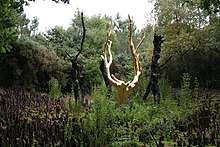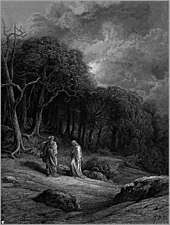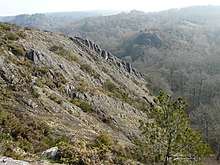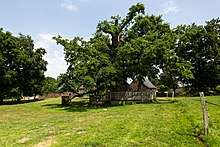Paimpont forest
Paimpont forest (French: Forêt de Paimpont, Breton: Koad Pempont) also known as Brocéliande forest (French: Forêt de Brocéliande) is a temperate forest located around the village of Paimpont in the department of Ille-et-Vilaine in Brittany, France. Covering an area of 9,000 hectares, it includes the castles Château de Comper and Château de Trécesson as well as the national historical site of the Forges of Paimpont, and is part of a larger forest area that covers the neighboring departments of Morbihan and Côtes-d'Armor. It has been associated with the forest of Brocéliande and many locations from the Arthurian legend, including Val sans retour, the tomb of Merlin, and the fountain of Barenton.
| Paimpont forest Forêt de Paimpont / Brocéliande Koad Pempont | |
|---|---|
.jpeg) | |
| Geography | |
| Location | Around Ille-et-Vilaine, Brittany, France |
| Area | 9,000 hectares (2010)[1] |
| Governing body | Mostly private, a small part under ONF |
| Ecology | |
| Ecosystem(s) | Temperate broadleaf and mixed forest |
Geography

The forest is located is the north-western France region of Brittany, about 30 km south-west of the city of Rennes. It occupies mainly the territory of the commune of Paimpont but extends to bordering communes in the department of Ille-et-Vilaine, mainly Guer and Beignon in the south, Saint-Péran in the northeast, and Concoret in the north.
The woodland surrounding Paimpont are the remains of a denser and much larger forest. It is mainly a broadleaved forest, mostly oaks and beech, with areas of conifers either inside after clear-felling or on the periphery as transition with moor, for example towards the west in the sector in the area of Tréhorenteuc and the Val sans retour. The relative altitude of the forested massif contributes to give it a climate close to the oceanic climate of the coasts of Finistère coast. This mode, where west and south-west winds carry of clouds and regular rain supports the vegetation, dominates. The surplus of water feeds the many brooks occupying the bottoms of small valleys before flowing into the river Aff, then the Vilaine, to the area around Redon in the south of Ille-et-Vilaine.
The altitude decreases regularly from the highest point to 258 m in the western part called high forest (haute forêt), regularly offering views towards the department of Morbihan; viewpoints which one finds the equivalents in the north on the commune of Mauron, port of the Côtes-d'Armor. The road from Forges to Concoret, which goes north through Paimpont, separates the high forest and the low forest, both of comparable size.
History
Paimpont forest has been designated as Brocélien in the 15th century. It was referred to in Breton name Brec'Helean. Because of its importance, the forest has been put under royal jurisdiction. It has been repeatedly exploited for construction needs of the city of Rennes, in particular in the 15th century.
The Forges of Paimpont were the most important wood forges of Brittany, operating from the 16th century until the end of the 19th century. Their location was enabled by the proximity of an open-cast deposit of iron ore at Gelée, a site near the village of Paimpont, the existence of a major river system, and the easy supply of locally produced charcoal. The forest was overexploited for the needs of the forges.
During the period of the French Revolution, the abolition of privileges triggered a massive clearings of forests as the wood was excessively exploited for the power supply of the charcoal blast furnaces for the local industry. In 1804, the prefect of the department wrote the forest at Paimpont was in state of degradation and threatened by complete destruction.[2]
In 1875, the forest was bought from Prince Philippe, Count of Paris by shipowner and industrialist Louis Levesque, "for rest and pleasure". The new owner created the Domaine de Paimpont and organized hunts of wild boars and deer. The exploitation of the forest by the local population was restricted to be only under licenses and the supervision of private forest rangers. Between the two world wars, the forest has been part of the hunting grounds of the Duke of Westminster.[3]
During World War I, the forest, deprived of most of its guards, was affected by major fires of unknown origin. During World War II, paratroopers of the SAS of Free France were dropped to join the partisans of the FFI in the forest with the mission of delaying German reinforcements as part of the Normandy landings in 1944.

In September 1990, a great fire devastated the forest of Paimpont and especially the Val sans retour, raging for five days.[4] Afterwards, during 1991-1992, thousands of volunteers planted more than half million new trees.[5] In the 1990s, a dam project on the Aff for the water supply of the Rennes region caused a controversy and protests before being abandoned.
Today
Forest management
The forest is an area of ZNIEFF and Natura 2000. It is owned mainly privately by those who maintain and exploit it for timber and for hunting; only a small part in the northeast (10%) is state owned and managed by the National Forest Office. This situation prevents free movement in the forest, even on the outskirts of the village and its lake. The owners have however signed an agreement authorizing the hiking, although some paths of the forest are closed during the hunting season between April 1 to the end of September.[6] Forest guards watch for behaviors that threaten the forest and its flora and fauna.
Tourism and legends

The Paimpont forest benefits from its association, since the 13th century, with the legendary forest of Brocéliande that has become the site of many episodes of the Arthurian legend in the French tradition. The identification with Brocéliande became institutionalized with the creation of the communauté de communes de Brocéliande, which was itself regrouped within a supra-intercommunal structure named the Pays de Brocéliande.
It has been a tourist site since the 19th century and especially after 1945.[7] Since 1951, followers of Neo-Druidism also meet there periodically, including in organized ceremonies.[8] The Paimpont sites are implemented through signs and pedestrian trails designed to introduce visitors to Arthurian locations, with explanatory panels linking each place to a legendary tale.
Locations
Building sites
Abbey of Notre-Dame
.jpeg)
The Abbaye Notre-Dame de Paimpont is a tourist and cultural location at edge of lake Paimpont. It is built in medieval Gothic style (walls, openings, baptistery and the Blessed Sacrament chapel, vault) with an interior (pulpit, statues, altars, altarpieces) in the Baroque style of the 17th century.
The abbey was built in the 13th century on the site of a priory founded in 645 by Judicaël, king of Dumnonia. It has been originally a Benedictine monastery, but from the 13th century has been inhabited by canons until the Revolution, when the abbey was nationalized and sold as biens nationaux in 1790.
Forges of Paimpont
The historical industrial site has been listed as a Monument historique since 2001[9] and has benefited from a reconstruction before it was opened to the public. Located in Ille-et-Vilaine, it is closer to Plélan-le-Grand than to Paimpont.
Château de Comper
It is a castle located in northern part of the forest, two kilometers east of the village of Concoret. From the 13th century, Comper has been one of the strongest positions of Upper Brittany. It has been the scene of much fighting, including being badly damaged by fire in out-of-control riots in the forest during the Revolution in 1790,[10] and has passed into the hands of several families. It now houses the exhibitions of the Centre de l'Imaginaire Arthurien (Center of the Arthurian Imagination). Adjoining the castle is a pond where, according to a local legend, the Lady of the Lake Viviane lived in her underwater crystal palace.[6]
Château de Trécesson

Located outside the village and the forest, immediately in its extension to the southwest, the castle was rebuilt in its current state in the 15th century. The most famous of the legends associated with it is the one of the Mariée de Trécesson (of "white lady" type) that unusually for the region has no Arthurian connections but instead seems to be inspired by a true story.[11]
Biological station
The biological station of Paimpont, under the University of Rennes, was built in 1966-1967. The forest and its varied environments provide a framework for many courses involving Rennes students in biology as well as many students and foreign researchers, the buildings to accommodate about 70 people. Although the first researchers studied at length the ecology of the moors, soils and hydrology, other works concern subjects far removed from the local biotope such as the behavior of primates.[12]
Megalithic sites
Hotié de Viviane
Also called the Maison de Viviane (House of Viviane) or the Tombeau des Druides (Tomb of the Druids), a funeral circle of stones dating from about 4,500 ago. It is located near the Val sans retour and has been known under this name since 1843.[13]
Tombeau de Merlin
In the northern part of the forest is the "Tomb of Merlin", a remnant of a Neolithic covered dolmen structure. It has been largely destroyed with dynamite by treasure hunters after the site became associated with the Arthurian figure of Merlin in 1889.[14]
_(14764599994).jpg)
According to the legend, having seduced Merlin, Viviane imprisoned him in an invisible prison, and then locked him in a tomb: Merlin, having lain down in a pit, had two enormous stones cast down on him. Today, it became an important site of neopagan pilgrimages. Visitors to the site might leave flowers and a note to Merlin, often with a wish,[6] or some kind of devotional object.
The Fontaine dite de Jouvence (Fountain of Youth) is a water hole near the Tomb of Merlin.[15] Also nearby there is an old tree known as the chêne des Hindrés.[16]
Tombeau du Géant
The tumulus consists of three or four menhirs erected 5,000 years ago. Three menhirs were reused in the Bronze Age about 3,500 years ago as a funerary vault; the fourth is on the ground about ten meters. Formerly covered with a mound of earth, the site is by its impressive dimensions nicknamed "Tomb of a Giant".[17] According to local tradition, it would be the tomb of a giant defeated by the Knights of the Round Table.
Jardin aux Moines
The "Garden of Monks", located in Néant-sur-Yvel, also called Jardin aux tombes ("Garden of Tombs"), is a megalithic tumulus dating from 5,000 to 4,500 ago.[18] It is one of the many such mounds present in this region.
Natural sites
Val sans retour

Val sans retour (the Vale of No Return) is the most famous tourist place of the forest, located near Tréhorenteuc, west of Paimpont. It is a steep valley dug deep in red shale, the color resulting from the oxidation of the iron ore it contains. During the 19th century, there have been two competing of locations of the Vale in the forest, the other one of them having been in the vallée de la Marette near the Tomb of Merlin and also including the initial location of the Tomb of Viviane, until Félix Bellamy decided in 1896 that this is the place that inspired the anonymous author of the 13th century to write the episode of the Vale in the Prose Lancelot.[19]
According to the French tradition of Arthurian legend, Queen Morgan le Fay, half-sister of King Arthur, betrayed by her lover, decided to keep all the unfaithful knights as prisoners in a vale of that name. Only Lancelot, faithful to Queen Guinevere, was able to break the spell, escape, and free the captive knights.
High above the Vale, the rocher des Faux-Amants (Rock of False Lovers) is the spot where Morgan le Fay is said to have turned her lover who betrayed her into stone. Another location is the Siège de Merlin (Seat of Merlin), a rock overlooking the valley.[6]
A lake that since the 1940s has been known as the Miroir aux Fées (Fairy Mirror) marks the entrance to the Vale.[20] Nearby stands also the Eglise du Graal (Church of the Holy Grail), a church that features famous images of Morgan and other Arthurian characters in the Vale.[21][22][23]
Remarkable trees
The forest of Paimpont contains several special trees. One of them is the hêtre de Ponthus (the beech of the Ponthus), being associated with the tale of Ponthus and Sidonia.[24]

The most famous is an old oak about 1,000 years old and more than 9 meters in circumference: the chêne à Guillotin (the oak of Guillotin), located between Concoret and Tréhorenteuc. According to a local legend, a refractory priest named Pierre-Paul Guillotin took refuge there during the French Revolution, continued to administer sacraments and blessings in the region, and wrote a valuable journal of revolutionary events.[25]
Fontaine de Barenton
The Fountain of Barenton (also known as Berenton, Belenton or Balenton) is located west of the forest, near the hamlet of Folle-Pensée, and is quite difficult to access. Quoted in medieval literature, this fountain has retained a feature already evoked back then: from time to time rosaries of bubbles rise to its surface. The site has become first associated with the legendary fountain of Brocéliande by Auguste Brizeux in 1836.[26] A local custom made young men and women visit the fountain in search of marriage.
It is here that Ywain, as described by Chrétien de Troyes in Yvain, the Knight of the Lion, challenged the Black Knight, guardian of the fountain. According to a late legend, this is also where Merlin met Viviane and the water of this fountain would have the power to cure mental illnesses.
References in popular culture
- In René Barjavel's 1984 Arthurian novel L'Enchanteur, the stone hill above the Val Sans Retour is actually Morgan's castle that, cursed by the Devil (Merlin's father), "has become a rock, from the top of which we have a bird's eye view of the wild valley. Tourists come, Japanese, Germans especially, some French too. They do not suspect that under their feet still rages the sister of King Arthur, imprisoned in a huge rock."
- The forest is the setting of the 2002 horror film Brocéliande.
References
- "« Document d'objectifs- Forêt de Paimpont – Tome 1 – rapport de synthèse sur l'état des lieux »" (PDF). .bretagne.ecologie.gouv.fr. Archived from the original (PDF) on 2008-12-06. Retrieved 2018-06-02.
- Mémoire sur les forêts et leur influence climatérique (in French). 1865.
- "En 1925 un certain Hugh Grosvenor à Rennes - WikiRennes". www.wiki-rennes.fr. Retrieved 2018-06-02.
- France 3 Bretagne (2014-01-15), 1990: l'incendie de Brocéliande
- "L'Arbre d'or - Encyclopédie de Brocéliande". broceliande.brecilien.org (in French). Retrieved 2018-06-02.
- "The enchanted wood". www.smh.com.au. The Age. March 26, 2005. Retrieved 2018-07-07.
- "Tourisme en Brocéliande - Encyclopédie de Brocéliande". broceliande.brecilien.org (in French). Retrieved 2018-06-02.
- "Cérémonies néo-druidiques en forêt de Brocéliande - Encyclopédie de Brocéliande". broceliande.brecilien.org (in French). Retrieved 2018-06-02.
- "Monuments historiques: Anciennes forges (également sur commune de Plélan-le-Grand)". culture.gouv.fr (in French). Retrieved 2018-06-02.
- "L'incendie du Château de Comper - Encyclopédie de Brocéliande". broceliande.brecilien.org (in French). Retrieved 2018-06-03.
- "La Mariée de Trécesson - Encyclopédie de Brocéliande". broceliande.brecilien.org (in French). Retrieved 2018-06-03.
- "Station Biologique de Paimpont". station-biologique-paimpont.univ-rennes1.fr (in French). Retrieved 2018-06-02.
- "L'Hotié de Viviane - Encyclopédie de Brocéliande". broceliande.brecilien.org (in French). Retrieved 2018-06-02.
- "L'allée couverte du Tombeau de Merlin - Encyclopédie de Brocéliande". broceliande.brecilien.org (in French). Retrieved 2018-06-02.
- "La Fontaine de Jouvence - Encyclopédie de Brocéliande". broceliande.brecilien.org (in French). Retrieved 2018-06-02.
- "Le chêne des Hindrés - Encyclopédie de Brocéliande". broceliande.brecilien.org (in French). Retrieved 2018-06-02.
- "Le Tombeau des Géants - Encyclopédie de Brocéliande". broceliande.brecilien.org (in French). Retrieved 2018-06-02.
- "Le Jardin aux Moines - Encyclopédie de Brocéliande". broceliande.brecilien.org (in French). Retrieved 2018-06-02.
- "Le Val sans Retour - Encyclopédie de Brocéliande". broceliande.brecilien.org (in French). Retrieved 2018-06-02.
- "Le Miroir aux Fées - Encyclopédie de Brocéliande". broceliande.brecilien.org (in French). Retrieved 2018-06-02.
- Lacy, Norris J.; Ashe, Geoffrey; Ihle, Sandra Ness; Kalinke, Marianne E.; Thompson, Raymond H. (2013-09-05). The New Arthurian Encyclopedia: New edition. Routledge. ISBN 9781136606335.
- "The Grail Priest - Eye Of The Psychic". Eye Of The Psychic. Retrieved 2018-06-02.
- "Tréhorenteuc - Church; Inside (4)". Global-Geography. Retrieved 2018-06-02.
- "Les ruines de Ponthus - Encyclopédie de Brocéliande". broceliande.brecilien.org (in French). Retrieved 2018-06-02.
- "Le Chêne à Guillotin - Encyclopédie de Brocéliande". broceliande.brecilien.org (in French). Retrieved 2018-06-02.
- "La forêt de Brocéliande - Encyclopédie de Brocéliande". broceliande.brecilien.org (in French). Retrieved 2018-06-02.
External links
| Wikimedia Commons has media related to Brocéliande. |
| Wikivoyage has a travel guide for Brocéliande. |
- Brocéliande | Brittany Tourism
- Tourist Office of Brocéliande, Paimpont
- Brocéliande.guide (in French)
- Destination Brocéliande (in French)
- Encyclopédie de Brocéliande (in French)